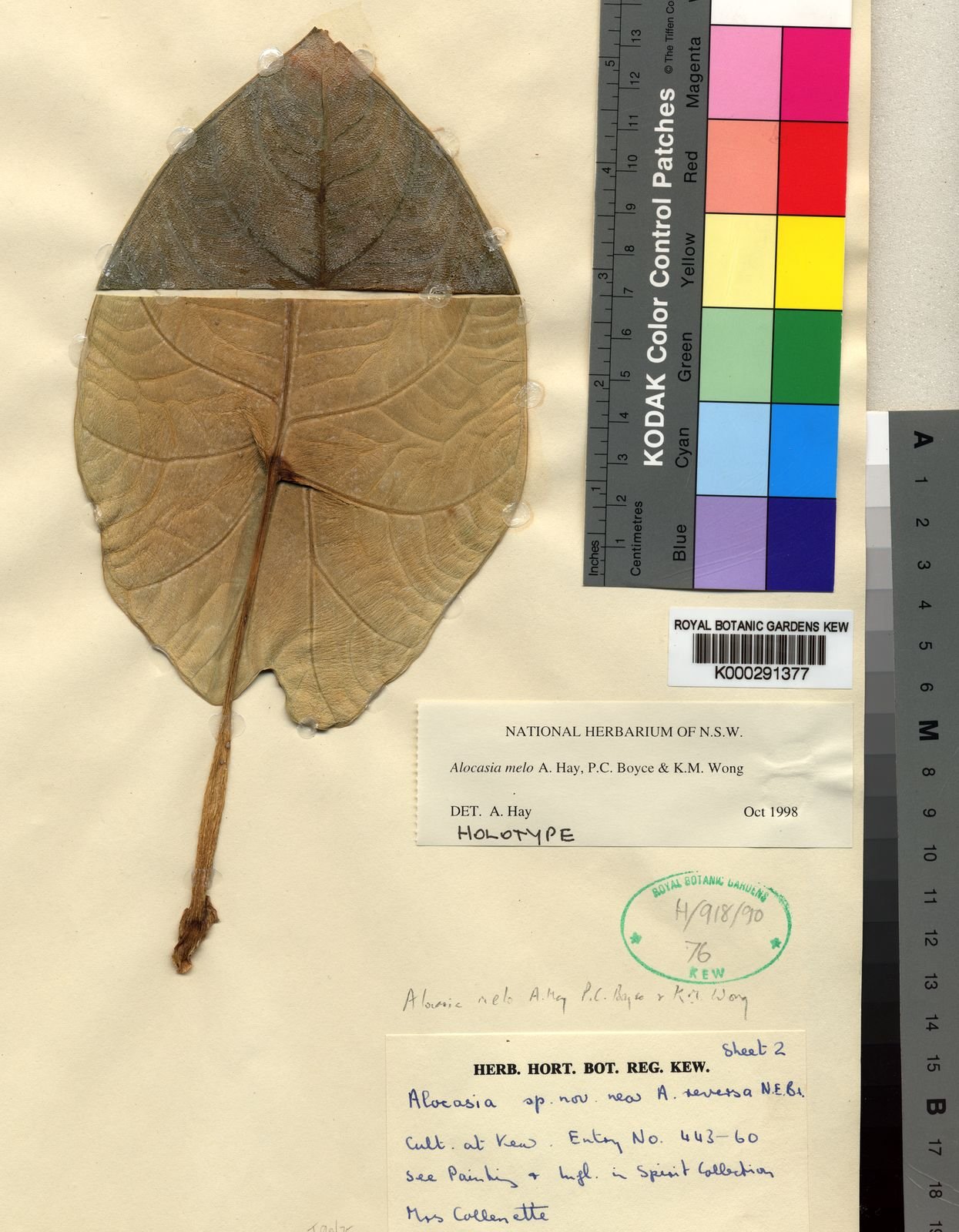ALOCASIA MELO
ORIGINAL DESCRIPTION:
Alocasia melo A. Hay, P.C. Boyce & K.M. Wong, sp. nov. Alocasiae guttatae N.E.Br./A. scabriusculae N.E.Br. affinis sed statura valde minore, folio peltato bullato superne rugoso, inflorescentia minore differt.
Typus. Malaysia: Sabah, Mrs I.S. Collenette s.n. Cult. Hort. Bot. Reg. Kew, Acc. No. 1960–443 (holotype K!, isotype K in spirit under no.22427!).
SYNONYMS: Alocasia rugosa, Alocasia ‘Rhino Skin’, Alocasia ‘Mythic Dragonite’ (incorrect renaming by Proven Winners)
DISTRIBUTION: Indonesia; Borneo
Endemic to Sabah, Malaysian Borneo. This species joins a growing list of rare and endemic plants peculiar to the ultramafic substrate in Sabah.
CLIMATE: Tropical humid climate
Humidity is moderate throughout the year, ranging from 60% to 70%
Temperature is varies between the seasons - within the range of 48°F/9°C to 88°F/31°C during the day. Minimum temperatures never dip below 45°F/7°C
Rainy and humid season (October to May) and a dry season between June and October. The average annual rainfall is 1,200 mm
ECOLOGY: Alocasia melo is found ultramafic rock, on the floor of tropical lowland rainforest, on thin soil along steep banks of fast-flowing streams, 120-400 m., so requires high temperatures and humidity and protection from direct sunlight.
SPECIES DESCRIPTION:
Small herb about 25–35 cm tall. Stem to about 3 cm diam., erect, short. Leaves to about 4 together, their bases overlapping. Petiole about 14–19 cm long, pale green, glabrous, smooth, sheating and sparingly burgundy-spotted in the lower fifth; wings of sheath rather broadly triangular. Leaf blade very broadly ovate to sub-orbicular, 18–25 cm long, 15 cm wide, rugose and bullate and very deep somewhat bluish green adaxially, smooth and pale greenish white abaxially, coriaceous, peltate; anterior lobe about 12.5–16 cm long, the tip broadly acute to obtuse and then shortly acuminate for about 1 cm and/or apiculate; posterior lobes to 8.5 cm long, united for 75–90% of their length; posterior costae diverging from one another at ca. 20–30G, poorly developed and not or hardly differentiated in size from the primary venation arising from the anterior costa; primary lateral veins (excl. posterior costae) 3–4 on each side of anterior costa, diverging at 90G (most proximal) to 45G (most distal), adaxially deeply impressed, abaxially more or less flush with lamina and dark green, irregularly bearing veins intermediate in thickness between primary and secondary venation, running the same course as the latter; secondary venation deeply impressed adaxially, abaxially somewhat raised and concolorous with abaxial lamina, arising at a wide angle (about 80G) from the primary venation and running to form quite well-defined intercostal collective veins; tertiary venation strongly raised adaxially into an irregular honeycomb pattern, abaxially imperceptible.
INFLORESCENCE:
Inflorescences paired, subtended by conspicuous broadly lanceolate persistent cataphylls about 8–10 cm long; peduncle about 5 cm long. Spatheivory-white, 9–16 cm long, constricted slightly less than half way from the base; lower spathe 84 ¥ Bentham-Moxon Trust 1997. burgundy-spotted, especially towards the insertion of the peduncle, ovoid, about 1.5 cm wide; spathe limb broadly lanceolate, strongy reflexed by male anthesis, the tip acuminate for about 1 cm, margins translucent, the entire limb swiftly withering and marcescent (in cultivation; probably deciduous or deliquescent in nature). Spadix shortly stipitate, much shorter than spathe, about 5 cm long, with the male and female zones enclosed within the lower spathe. Female zone 1.2 cm long, 1.3 cm wide at base, tapering distally. Ovaries pale green, about 1.5–2.2 mm diam., ovoid, partially 2–3-locular with 2–3 intrusive basal to sub-parietal placentae; style virtually none, stigma 2–3-lobed, orange-brown. Ovules orthotropous, 2–3 per locule. Sterile interstice much narrower than female zone, about 5 mm long, 1.2 mm thick, bearing a few somewhat distant white synandrodia. Male zone cylindric, pale ivory-white, 1.3 cm long, 4–6 mm thick. Synandria rhombohexagonal, 1–2 mm across; anthers opening by apical pores visible on the spadix surface. Appendix ivory-white, cylindric-subclavate, 1.7 cm long, 4 mm thick. Infructescence peduncle about 12 cm long; fruiting spathe ovoid, about 4 cm long; ripe fruit unknown.
VARIEGATED FORMS: WHITE
ETYMOLOGY: The specific epithet ‘melo‘ is derived from the thick almost circular, bullate and rugose leaves rather resembling the rind of a canteloupe melon
NOTES:
A plant of this species was in cultivation at Kew in the early 1960s, when it was painted by Mary Grierson and a specimen was preserved. Though known to have been from Sabah, the precise origin of the plant is obscure. Around 1987, Dr D.H. Nicolson (Smithsonian Institution, Washington D.C.) drew the existence of the painting to the attention of Alistair Hay, and suggested that it represented an undescribed species. Recent work on the revision of Alocasia in West Malesia for the Flora Malesiana account of Araceae (see Hay, 1994b), confirms that this is so. A collection made in 1964 with known provenance has now been found in the herbaria at Sandakan and Leiden. Moreover, living material has been collected by K.M.W. and A.H. in Sabah, and is now in cultivation at the Forest Research Centre, Sepilok and at the Royal Botanic Gardens, Sydney.
The new species evidently belongs in a complex grouping of Bornean and Philippine elements including Alocasia scabriuscula N.E.Br., Alocasia heterophylla (Presl) Merr. and perhaps others, in which species limits are mostly very difficult to define though there is a great deal of variation in vegetative aspects. The group is characterized by the spathes generally ivory-white throughout (including the lower spathe which is more generally green), variously dotted, streaked, edged or suffused with purple. The spathe limb typically becomes very fully reflexed at the point of constriction towards the end of female anthesis. The spadices are also generally ivory throughout, with little if any development of chlorophyll in the ovary at the flowering stage. The leaves are distinctly leathery in texture, with the petiole often scabrid. Although species limits are very hard to define over the entire range of the group, quite distinct forms may co-exist in particular localities. In spite of the complex pattern and great degree of variation and blurred species limits in this group, the new species is nevertheless easily distinguished and appears to be a segregate restricted to the ultramafic substrate. In aspect it comes closest to very immature plants of A scabriuscula but adults of that element are significantly larger, have markedly different leaf proportions and lack the bullate rugose texture of the leaf blade.
This species is the only one so far known to be confined to ultramafic substrate, though Sulawesi Alocasia balgooyi shows a rather strong association with it.
The peculiar finely and strongly rugose adaxial leaf surface appears to be unique in the genus
At Sepilok it has been successfully maintained in pots in ordinary loam under shady conditions. At Sydney it is growing under glass in an open soil mix incorporating 75% perlite and 25% composted pine needles with gypsum, epsom salts, iron sulphate, agricultural lime, dolomite and a little copper sulphate added. The plants are liquid-fed about fortnightly and occasionally dressed with poultry manure. No specific provision is made for the fact that the species grows in ultramafic sites in nature and the plants are healthy, although they have not yet flowered.
Other specimens seen. Sabah: Tongod, G. Tingkar, Hay & Wong 12001 (no voucher), cult. Royal Botanic Gardens Sydney, Acc. No. 960489 (NSW, sterile); Beluran, Porog, west side of Bidi Bidu near Kubar Labuk, Meijer 41241 (L, SAN); Tongod, G. Tingkar, Radin s.n. (no voucher), cult Forest Research Centre, Sepilok & Royal Botanic Gardens Sydney, Acc. No. 950381 (NSW, sterile).
Alocasia melo can be easily told apart from its Alocasia ‘Maharani’ offspring based on:
- venation color: The hybrid will have distinctly lighter veins while Alocasia melo shows a uniform coloration
- leaf texture: Alocasia melo leaves are much stiffer, with deeper embossing
- leaf color: Alocasia melo will havedarker/grayer leaves
- abaxial color: Alocasia melo will have light green abaxials, while Alocasia ‘Maharani’ retains the red of Alocasia reginula ‘Black Velvet’
CULTIVARS: N/A
HYBRIDS:
Alocasia ‘Dragon Moon’ (Alocasia baginda ‘Silver Dragon’ x Alocasia melo)
Alocasia ‘Green Bold’ (Alocasia reversa x Alocasia melo)
Alocasia ‘Java Miracle’ (Alocasia azlanii x Alocasia melo)
Alocasia ‘Maharani’ (Alocasia reginula ‘Black Velvet’ x Alocasia melo)

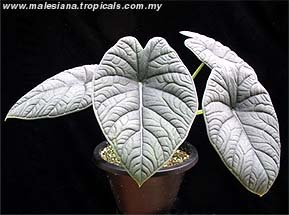
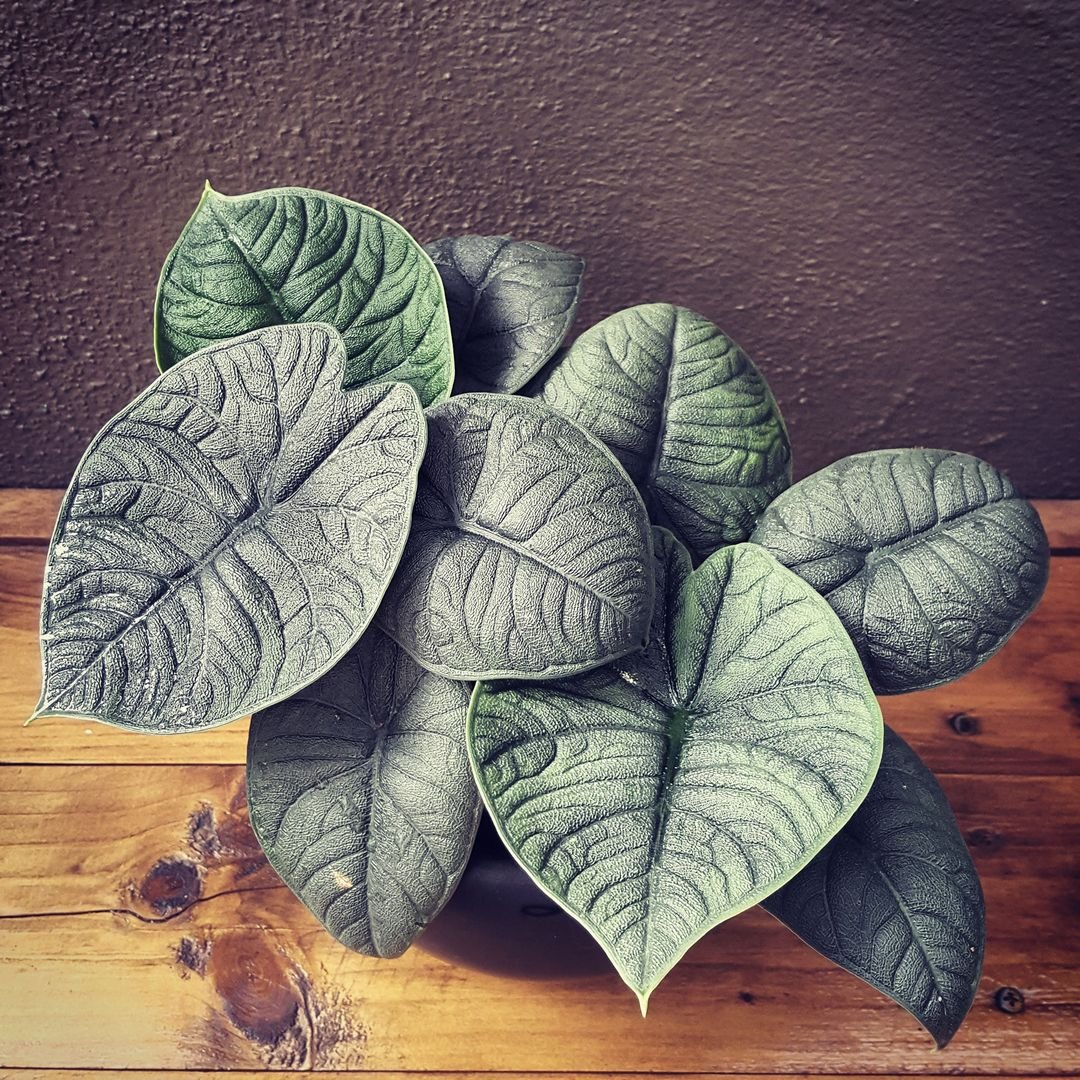
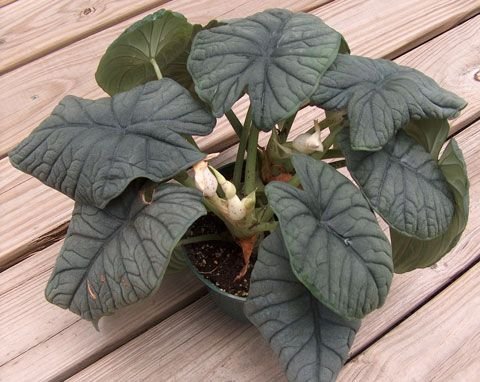

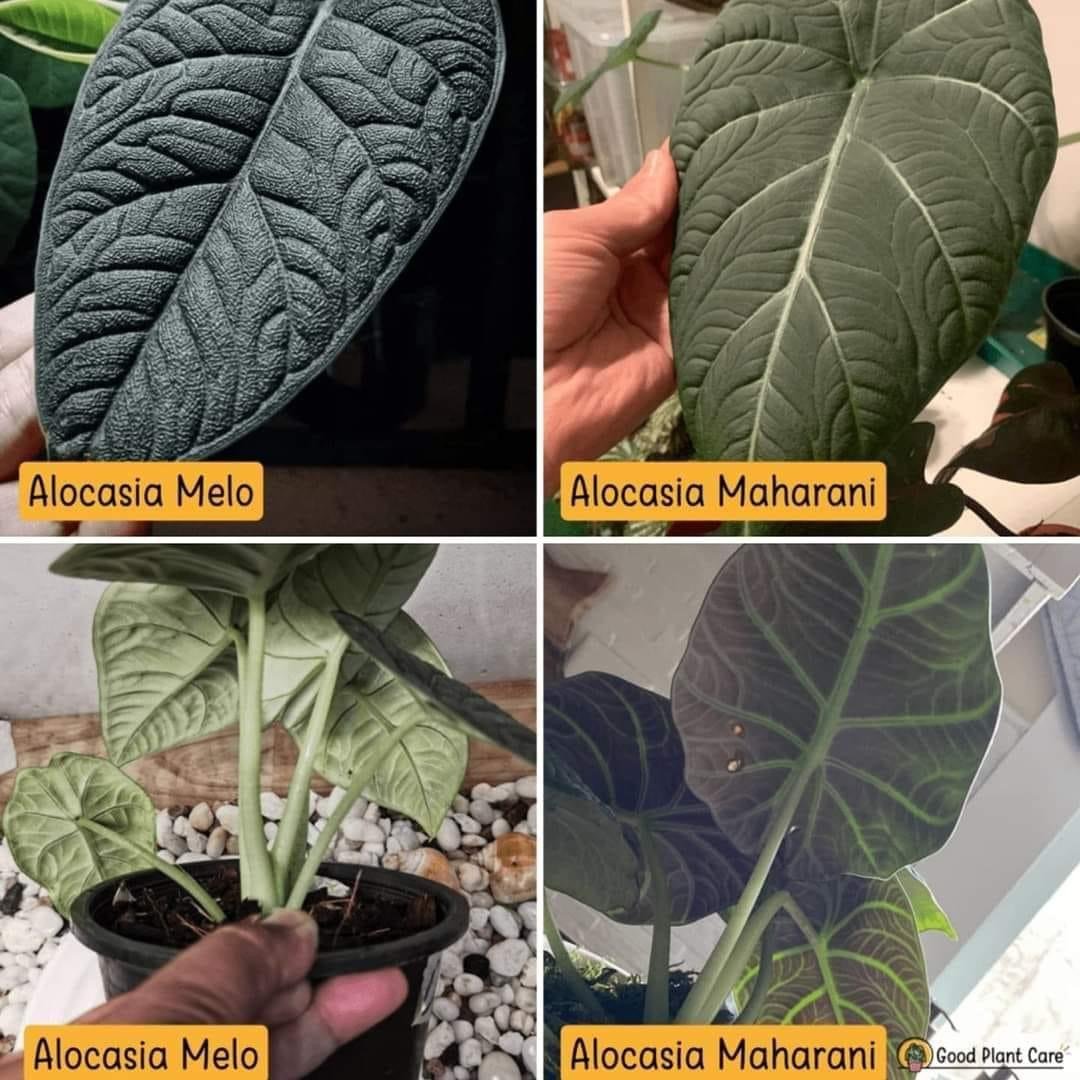

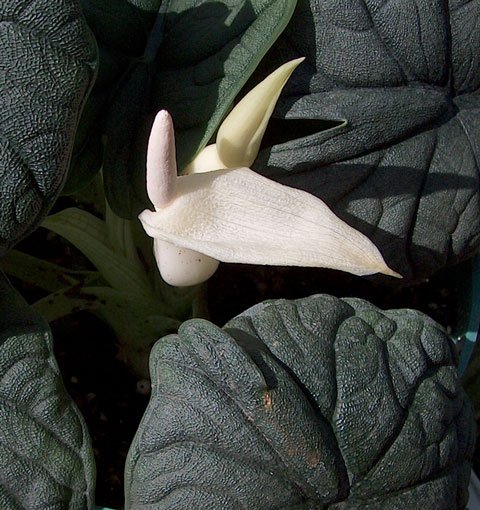

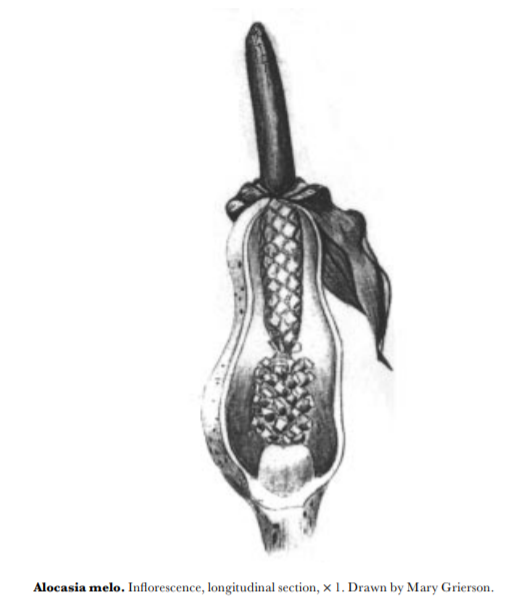
![Alocasia melo - [Curtis's botanical magazine 14(2) 82GÇô86, Pl. 315] - Hay, Boyce & Wong 1997.PNG](https://images.squarespace-cdn.com/content/v1/5ecee8ccbaacf76f4d3ca700/1756090334662-WF4QG9UAV6PPFA90A4CF/Alocasia+melo+-+%5BCurtis%27s+botanical+magazine+14%282%29+82G%C3%87%C3%B486%2C+Pl.+315%5D+-+Hay%2C+Boyce+%26+Wong+1997.PNG)
